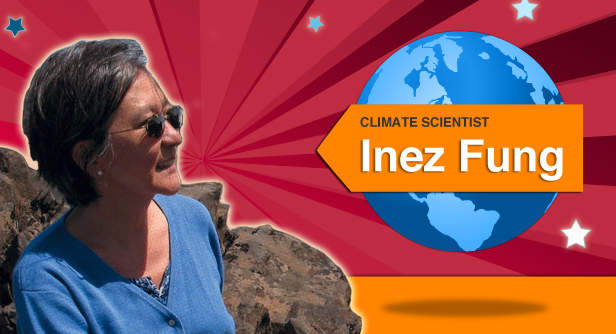Inez Fung is on a mission to find and account for every gram of heat-trapping carbon dioxide on the planet. And she knows where most of it is hiding.
Fung is the director of the Berkeley Institute of the Environment at the University of California-Berkeley. Her work has led to a more complete understanding of the current and future role played by Earth’s so-called “carbon sinks” — features such as oceans and forests that suck carbon dioxide out of the air. Fung’s research shows that when the role of these carbon-absorbing mechanisms is taken fully into account, global warming is likely to accelerate even faster than scientists previously believed.

Why study carbon sinks? Because the planet’s ability to absorb carbon dioxide is a vital and tricky part of the climate-change equation. Up until now, Earth’s land, vegetation, and oceans have soaked up roughly half of all the heat-trapping CO2 we have emitted by burning fossil fuels. Fung’s research analyzes whether our carbon sinks can keep pace with today’s unprecedented levels of CO2 emissions. The stakes are high, because any reduction in the Earth’s ability to absorb CO2 could dramatically increase the swiftness and severity of global-warming processes now underway.
As high as the stakes may be, the planet’s so-called “carbon dynamics” are tough to master, requiring a detailed knowledge of everything from atmospheric transport models to the mechanics of photosynthesis. Luckily, Fung is well suited to the task.
She has always loved math. “It’s no doubt irksome to some people,” she says, “but I see everything through the lens of mathematics.” She graduated from MIT with a degree in applied mathematics. After deciding to stay on for a PhD, she took the field of meteorology by, well, storm, when she used math and fluid dynamics to explain the spiral shape of hurricane rain bands.
Weather is Fung’s other passion. As a child growing up in Hong Kong, she monitored the harbor lights, which were put in place to warn of an impending typhoon. “Of course, back then,” she says, “we were mostly excited about [typhoons] because it meant school would be canceled.”
After grad school, Fung joined a climate-modeling team led by the well-known climate scientist James Hansen at NASA’s Goddard Institute for Space Studies at Columbia University in New York. It was there, she says, that she started thinking in earnest about Earth’s carbon cycle. It seemed obvious to her that carbon sinks had to be included in any analysis of climate change. Without that factor, she says, the results would be as incomplete as “trying to make a budget by looking at your income without considering your expenses.”
Fung learned about carbon sinks on her own, from scratch. She married Jim Bishop, a marine chemist, and she and her husband often went on camping trips with other scientists. On hikes and around the campfire, she would buttonhole colleagues to learn everything she could about the arcane aspects of the carbon cycle, often taking notes on what they told her. Before long, she determined that Earth’s uptake of carbon “could be reduced to seven equations with seven unknowns.”
Fung’s analysis derives from the fact that there are a finite number of major types of carbon sinks. The oceans are one type. Researchers know that oceans absorb heat-trapping CO2 from the atmosphere as surface water mixes with air. Marine creatures incorporate this dissolved CO2 into their shells.
Terrestrial plants also trap carbon. They take in CO2 and, through the process of photosynthesis, turn it into carbohydrates, which are stored in leaves, trunks, or roots. When leaves fall or the plants die, soil microbes decompose the plant detritus and return the CO2 to the atmosphere.
Before Fung’s work, most scientists studying the carbon cycle had focused on one or another specific carbon-trapping mechanism, such as the ecophysiology of leaves from a particular tree. As valuable as that research is, it is too fine-grained for Fung’s purposes. As she puts it, “[It’s] like trying to determine how the economy is doing by looking only at one corner store.”
Fung prefers to think about the carbon cycle at the biosphere scale. The rise in overall levels of CO2 grabs all the headlines, but Fung and her team focused on the seasonal fluctuations in CO2 data collected from around the world. They noticed that concentrations reach their highest levels in May, before the growing season begins and photosynthesizing new foliage draws the levels down. “We look at these records in great detail to derive everything we can about the biosphere,” she explains. “It is like you can see the Earth breathing.”
Before long, Fung’s detailed data analysis helped her build a large-scale computer model to represent the geographic and temporal variations of CO2 sources and sinks. More recently, Fung has coupled her carbon-cycle model with existing large-scale computer climate models to project how land and ocean carbon sinks are likely to change as global warming proceeds.
One major finding: droughts have already diminished the carbon absorbing capacity of the land and will continue to do so. Previous greenhouse experiments suggested that elevated CO2 levels caused plants to grow bigger and faster, an effect known as CO2 fertilization. The implication was that land-based carbon sinks — that is, plants — might be able to keep pace with higher CO2 levels. Fung’s modeling shows that on a global scale, regional droughts are likely to curtail this effect.
Her model also projects that the tropics are likely to become hotter and drier in summer months. As that happens, plants will absorb less carbon dioxide as a way to avoid water loss. In fact, atmospheric measurements over the past decade have already confirmed this effect. Fung says that her research shows that soil moisture is a key variable, and she worries that increasing regional droughts will further hasten warming trends.
After initial skepticism, Fung’s colleagues now pay close attention to her analysis. Her work is widely cited, and she has won many accolades, from attaining membership in the National Academy of Sciences to being named one of Scientific American‘s 50 most influential scientists in 2005. Her life and work are the subject of an online comic strip aimed at middle schoolers.
Fung’s efforts will get a big boost with the 2013 launch the new Orbiting Carbon Observatory (OCO-2) satellite. OCO-2 will collect an unprecedented volume of data on the levels of heat-trapping CO2 in the atmosphere. As Fung explains, she will go from being able to draw upon roughly one hundred observations of near-surface CO2 concentrations every two weeks — from remote locations around the world — to a million. In addition, OCO will record CO2 levels through the entire atmospheric column, eliminating the need to guess about variations at different altitudes.
Not surprisingly, Fung sees the tough policy choices that global warming presents as a complex math problem. “In considering something like climate change, the political arena has to weigh many, many variables, from economic to environmental considerations. In math we call this a weighting function, and it all depends on how you weigh these different variables. I don’t know the best way to do that. What I do know is that my role is to offer the most accurate analysis I can of what is happening.”
“Unfortunately,” Fung says, “I don’t think we scientists have done very well communicating the issues to the public. We do a lot of talking to one another. But I still haven’t seen any of my friends on Oprah yet. I’m afraid we are not broadcasting our findings on the right wavelength.”
This is the 10th installment of America’s Climate Scientists: A series from the Union of Concerned
Scientists. Click here to read all the climate scientist profiles.
The Union of Concerned Scientists is currently leading a campaign to elevate the voices of climate scientists and educate the public about the overwhelming scientific evidence for human-caused global warming. Learn how you can get involved at www.ucsusa.org/evidence.


